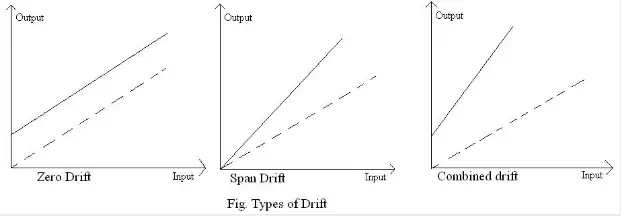In this article, we will learn about two important terms Reproducibility and Drift. These two terms are important for instruments in measurements.
Reproducibility
Contents
show
Reproducibility is defined as the degree of closeness with which a given value may be repeatedly measured.
Drift
Drift is the gradual shift in the indication or record of the instrument over an extended period of time, during which the true value of the variable does not change.
No drift means that with a given input the measured values do not vary with time. Drift is an undesirable quality in instruments. So instruments are properly guarded against drift.
Drift are of three types
- Zero Drift
- Span Drift or Sensitivity Drift
- Zonal Drift
1. Zero Drift
In this case, the output values shift by the same amount from the normal value. It is to due to undue warming up of tube of electronic tube circuits, slippage. It is prevented by zero setting.
2. Span Drift or Sensitivity Drift
In this case, the output value is a proportional change from the normal value. If there is a proportional change in the indication all along an upward scale, the drift is called span or sensitivity drift. Hence higher calibrations get shifted more than lower calibrations.
3. Zonal Drift
In case the drift occurs over a certain portion of the span of an instrument, and remaining portion of the scale remains unaffected. Such a drift is called as zonal drift.
 |
| Types of Drift |
Causes of Drift
- Electric and Magnetic fields
- Thermal EMFs
- Temperature Change
- Mechanical Vibrations
- Wear and Tear in mechanical instruments
- High stresses
What do you mean by Perfect Reproducibility?
Perfect Reproducibility means that the instrument has no drift.
Repeatability
Repeatability is a measure of closeness with which a given input may be measured over and over again. Here the terms Reproducibility and Repeatability may cause confusion.
Reproducibility is specified in terms of scale readings over a given period of time while Repeatability is defined as the variation of scale reading and is random in nature.
Excercise
Q1. What do you mean by Reproducibility?
Q2. What do you mean by Drift?
Q3. What are the types of Drift?
Q4. What are the causes of drift?
Q5. What is the difference between Reproducibility and Drift?
Q6. What do you mean by no drift?
Q7. Explain Repeatability?
Q8. Differentiate between Repeatability and Reproducibility?
Q7. Explain Repeatability?
Q8. Differentiate between Repeatability and Reproducibility?

when drift can be ignored